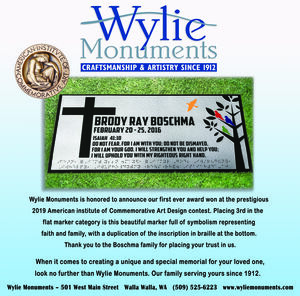Forsyth: From Catastrophe To Grace
September 16, 2010

Michelle Forsyth prepares to stretch her carefully crafted installation representing the natural environment at the site where Swissair Flight 111 crashed in 1998.
WAITSBURG - When Swissair Flight 111 went down off the coast near St. Margarets Bay, Nova Scotia, in 1998, a newspaper account
of the crash described the nighttime waters at the site as "inky." Canadian artist Michelle Forsyth took that description to set the context for a sculpture she dedicated to the air disaster that killed all 229 aboard. Her piece, "For September Second," is now on display at AMO Art Gallery on Main Street, open by appointment. She worked the nighttime darkness into her installation by using a charcoal-black platform on which to set her screen-printed waves of gray paper silhouettes representing the vegetation native to the crash site. On the black surface, the size of an extra-large dining table, the waves of outlined plants and flowers gleaned from her visit to St. Margarets Bay are shrouded in the opacity of that day's fog. They're trimmed with sequins to reflectthe glitter of the damp air and the airplane's

cargo of diamonds that was never found.
"I was going to do a hanging piece of the plane going down, but I realized it was going to work much better as an installation on the ground," said Forsyth, whose art has thus far been vertical rather than horizontal. "I'm excited to see what it will look like at night." Forsyth's exhibition of "For September Second," which also includes a wall-mounted quote from a rescue diver who searched for bodies on the sea floor, will be at AMO Art through October. "It's hard to imagine or describe what's down there because it's unbelievable," Forsyth quotes the diver as saying in her wall-mounted text by the sculpture. Though her first-ever ground installation, Forsyth's no stranger to creating art based on disaster sites using the site's natural milieu and local aspects that are "impermanent," she said.

Her website puts it this way: "Her work examines traumatic cultural events and incidents of human suffering depicted in the media." But rather than relying on interpretations generated by others, such as photographs or descriptions, as she did in the beginning of her period rendering catastrophes, she chooses more and more to have her own experiences where the trauma occurred.
"Our memories of these 'stories' are constructed by others," said Forsyth, who was in New York when 9/11 happened. "I want to subvert that process."
To Forsyth, who now teaches at Washington State University as an associate professor in painting and drawing, the process of creating the components for her art installations - often consisting of thousands of individual items - is as important as the end result itself.

On this artistic journey she calls "cathartic," she meanders for months generating and shaping just the right materials to "construct" an image. She once produced an exhibition of wall installations
called "Flowers For Iraq," which were made of more than 6,000 pieces forming individual flowers, each color painted according to the single dots from the screen print of photographs depicting traumatized bodies of war victims. Up close, the "flowers" are akin to single trees in a forest. Step back and they come together like pixels in a digital image. The effect is like a three-dimensional pointillism because the flowers
are mounted with pins that cast a shadow on the wall behind them. Similarly, Forsyth worked for months on a piece representing the explosion of two ships in a Halifax port. She has traveled to ship wrecks and oil spill sites, though not the recent one in the Gulf.
But why disasters? "When I was little, my dad was always reading books about peril and demise,
stories about survivors at sea for instance," said Forsyth, who started picking them up and reading them. Much later in life, she was deeply affected by being in Manhattan during 9/11, an experience she hasn't transformed into art. An artist for much of her career, Forsyth received an associate of visual arts degree
from Camosun College in British Columbia in 1993, followed by a bachelor's of fine arts from the University of Victoria in 1996 and a master's of fine arts from Rutgers University in New Jersey. She has exhibited work through North America and parts of Europe. Her pieces have shown at the Northwest Museum of Arts and Culture in Spokane and the Kirkland Art Center, in Kirkland, Wash.
"Consisting of watercolor, gouache, screenprint and cut-paper, my work focuses on subjects often associated with tragedy and loss," she writes in her artist's statement.
But Forsyth isn't obsessed with the dark side of disasters as the violent end to lives. To her, it's as much about her own experiences at these sites and offering grace to those who died there by dedicating so much of her time to the pieces' creation and installation. Sometimes, she works in materials like those left by survivors of the victims, such as artificial flowers or silk ribbons. "Using a compassionate process that is part requiem and part cathartic obsession, I translate these presences into thousands of sinuous loops of undulating color, intricately stacked and cut-paper flowers, and diluted layers of watercolor to inscribe these images with traces of my own gestures, simultaneously testing the imprint of my own presence while evoking ideas about memory, loss and grief." And she does her research to capture a site's authenticity. At WSU, she has access to the school's herbarium to find the sites' plants and flowers. With "For September
Second," she took photographs of the pressed specimen she needed, then traced them in the computer program Adobe Illustrator to come up with the shape of the waves. The waves themselves were scientifically mapped on pieces of paper, stitched and zip-tied before the harmonica like ensemble was stretched like a paper cutout and placed on the "inky" platform less than a foot off the floor.

It took Forsyth several trips to AMO Art over the course of a week to decide on the optimal installation. She raved about the space with its wood floors and blue-painted wooden ceiling that reinforces the at-sea atmosphere of her piece. "(Gallery co-owner) Claire (Johnston) is really open and free about the use of her gallery space," Forsyth said as Johnston was helping her set up the installation. "It helps me push the boundaries of my work." Forsyth's exhibit opened September 4 (two days afterthe crash anniversary) and will run until Oct. 30: www.amo-art.com; 509-876-1264. AMO Art is at 117 Main St. Please call for an appointment.






Reader Comments(0)